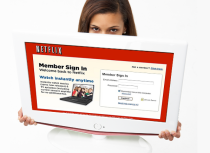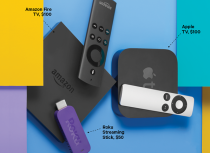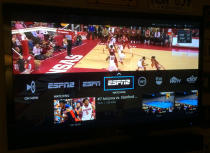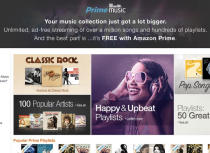Is it okay to share log-ins for Amazon Prime, HBO Go, Hulu Plus, or Netflix?
Hans doesn’t want his last name revealed. That’s because the 22-year-old, who attends college in Oregon, is on shaky legal and ethical ground. For the past few years, Hans’ entire family has logged into HBO Go using the credentials of his sister’s ex-boyfriend, accessing the cable channel’s Internet streaming service to watch movies and TV shows. Hans has mixed feelings about leeching off the former beau, a cable subscriber who apparently doesn’t change his password very often. But those concerns don’t extend to HBO. “I’m not feeling super guilty about it,” Hans says.
Apparently, a lot of people feel the same way. A survey conducted in December 2014 by the Consumer Reports National Research Center revealed that 46 percent of American adults with streaming media accounts admitted to sharing log-in credentials with people living outside of their homes, which could include kids living at college, other family members, and friends. And the numbers are likely to grow as streaming video becomes more popular. Our survey found that about half of U.S. households reported having access to at least one of the big services: Amazon Prime Instant Video, HBO Go, Hulu Plus, Netflix, or WatchESPN.
The situation would seem certain to provoke a corporate backlash. Are cease-and-desist orders and lawsuits poised to be unleashed on consumers? In short, the answer is no—at least not yet. Streaming media companies contacted by Consumer Reports said they had no plans to get tough with cheaters. Cliff Edwards, a Netflix spokesman, told us that a crack-down is “honestly not even a conversation in the company right now.”
Before you buy a streaming media player check our buying guide and Ratings.
However, streaming services could reconsider their stance on account sharing as business models evolve. This year HBO plans to start allowing users to purchase access to its streaming content without a cable TV subscription, which is currently required. By early January, the company hadn’t said what the service would cost or what content would be available. But if a new streaming-only service eventually prompts fans to drop HBO channels from their cable packages, the company could choose to clamp down on freeloaders to avoid losing subscription revenue.
A new, punitive era seemed to be starting back in 2011, when Tennessee made account sharing illegal. Since then, however, streaming content providers haven’t shown any interest in using the law. In fact, Netflix has softened its rules. A few years ago, subscribers were required to register each device they wished to use—a Roku player, a tablet, or a laptop, for instance—with a total limit of six devices. That policy has been dropped. One 37-year-old woman living in New York City (who requested anonymity) has shared her Netflix log-in with her extended family in the Dominican Republic. “Then one cousin told another cousin,” she says. “I’m pretty sure it went far and wide out there.” If account sharing across national borders doesn’t trip alarms at Netflix, it’s hard to imagine what will.

Company priorities aside, it is unclear whether people who widely share log-in credentials are breaking criminal laws, at least outside of Tennessee. Some violations of online terms of service could potentially violate federal criminal laws. But the language used in those agreements can be ambiguous.
Consider Amazon Prime Instant Video. In one document on its site, Amazon says, “You can stream up to two titles at the same time using the same Amazon.com account.” Yet, elsewhere the company states that although Amazon Prime members can share their shipping discounts within certain limits, “other Amazon Prime membership benefits such as Prime Instant Video, Prime Music, and the Kindle Owners’ Lending Library can’t be shared.” Read literally, the statements conjure the strange scenario of an Amazon Prime user viewing two different Prime streams on two devices at the same time. It’s more likely, though, that a spouse or child in the household would view the second stream.
In other cases, a company’s terms of service are undermined by public statements from executives. For instance, HBO Go’s terms of use state that access to each account is to be “limited to members of your immediate household only.” And a statement provided by a representative reads in part, “The HBO Go service is meant to be used by the members of a household with an HBO subscription. We do not encourage password sharing outside of that household, and we limit viewing to three concurrent streams.”
Last year, however, company CEO Richard Plepler told BuzzFeed that account sharing is “in many ways a terrific marketing vehicle for the next generation of viewers, and it is actually not material at all to our business growth.” People apparently pay more attention to such statements than to click-through agreements. One consumer who admits to sharing log-in credentials wrote in an e-mail that using a parent’s HBO Go password was not only common, but “I think even officially endorsed by HBO.”
Find out whether cutting the cable cord can really save you money.
As for the leader in the field, Netflix doesn’t specify in its terms of service who can share access, though it says that account owners shouldn’t share their log-in information with anyone. Four people can stream content simultaneously under the $12-per-month premium plan. However, company CEO Reed Hastings clarified his perspective during a 2013 earnings call. “We usually like to think that a husband and wife can share an account and that that’s perfectly appropriate and acceptable,” he said. “If you mean, ‘Hey, I got my password from my boyfriend’s uncle,’ then that’s not what we would consider appropriate.”
That might be news to Hans. Though his family doesn’t subscribe to HBO, it does have a Netflix account—and his sister shares the log-in credentials freely. The password is so well-traveled that users regularly run up against the simultaneous streaming limit. To watch a movie, someone in the family winds up changing the password every three to six weeks, Hans says. The account has been accessed by at least 25 people, and counting. Netflix has shown little sign that it is concerned about such widespread account sharing, however—and for good reason.
Despite the superficial similarity, streaming video providers aren’t facing the same danger that the music industry did in the early 2000s, when digital file-sharing services such as Napster were cutting into physical CD sales and companies fought to shut them down. Streamed content is different from pirated movies, songs, and television shows that are distributed as bootleg discs or as downloadable torrents. Each illicitly shared single, album, film, and TV episode represents an enduring loss for the company that owns it. Once you have one digital copy of “The Lego Movie,” there’s no reason to buy another one later. Streaming services are more like utilities. Once hooked, users will keep coming back for fresh content every month—and they’ll still want it even if today’s freewheeling culture of shared log-in credentials comes to an end.

The streaming services aren’t looking the other way by accident, says Dan Rayburn, principal analyst at Frost & Sullivan and a founding member of the Streaming Video Alliance. “If they really felt the impact to their bottom line in some way, they’d do something about it,” he says. If you think about it, the situation could become a problem for cable TV providers long before a streaming service such as Netflix has reason to worry. If you can get great TV and movies free, you might be tempted to drop your entire cable TV package. The pressure on the cable industries has just increased with a new player in the field, Dish's over-the-Internet Sling TV service. However, despite the attention paid to cable cord-cutters, the numbers are still small. “For 2014, it looks like, combined, all pay TV providers [lost] about 400,000 subscribers,” Rayburn says. “That’s not even half of 1 percent of the total pay TV market.”
Assuming streaming providers eventually decide to crack down, it will be easy. HBO Go, for example, allows up to three concurrent content streams; engineers could throttle that back. Or they could force users to register a limited number of devices for use with their streaming service.
If executives feel like putting their attorneys to work, they might start pursuing violators for breach of contract, tightening up their terms of service where necessary. But analysts and attorneys we asked didn’t expect that to happen soon. “The cost of pursuing a legal claim is extraordinary, compared to the breach of the terms of use,” says Miles Feldman, an entertainment and IP attorney, and litigation partner at Raines Feldman in Beverly Hills. “And they don’t want to alienate their user base.” That’s a lesson learned from the missteps of the music industry.
For now, consumers who are happily squatting on other people’s streaming accounts are living through halcyon days. And they will last as long as building the market for streaming content is more important to corporate players than plugging leaky revenue pipes. In the words of HBO’s CEO: “We’re in the business of creating addicts.”

Each streaming service sets its own rules on account sharing. Generally, it's fine to share your log-in credentials with family members living at home, and it's probably okay to provide the information to kids who are away at college. But these services frown on sharing your account with other friends, family, and acquaintances. (For your own security, remember that people who have your log-in credentials can change your account settings and see some of your personal data.) This table summarizes the basics as outlined in each company’s published policies.
Amazon Prime | 2 | $99 per year (including free two-day shipping) | Although Amazon doesn’t explicitly limit video streaming to those in the Prime member’s household, other clauses are confusing. |
HBO Go | 3 | Included with broadcast HBO subscription | HBO is clear-cut in its stated account sharing rules, limiting streaming to a single household. |
Hulu Plus | 1 | $8 per month | By allowing only a single stream per account and stating that it’s for individual use only, Hulu plus strongly discourages account sharing. |
Netflix | 1, 2, or 4, depending on your plan | $8 to $12 per month | Netflix’s rules are worded so permissively that it’s hard to imagine the company objecting to account sharing. |
WatchESPN | No stated policy (we created six concurrent streams and never hit a limit) | Included in price of most cable/ satellite subscriptions | ESPN does little to restrict account sharing—it uses the vague guidelines of other online products owned by Disney and does not specify a limit on concurrent streaming. |

Attention, would-be cord-cutters: Dish Network has a new, low-priced offering that could have you sharpening your scissors. The satellite TV company’s Sling TV service streams live and on-demand TV programming via an Internet connection to TVs, smart phones, tablets, and computers for just $20 per month—far less than the typical cable or satellite TV bill.
Sling TV was announced at the 2015 Consumer Electronics Show in early January, and Consumer Reports has reviewed the service. Read our first look to find out how Sling TV compares to cable and satellite.

Americans love streaming services
51% of U.S. households say they access Amazon Prime Instant Video, HBO Go, Hulu Plus, Netflix, and/or WatchESPN.
Especially younger Americans
68% of those ages 18 to 44 vs. 37% of those ages 45-plus use those services.
And they share their passwords freely
46% of respondents who use a streaming service share their account with someone outside their household.
Subscribers who share their account with someone outside their household
(Sample sizes for HBO Go and WatchESPN were too small to report percentages.)
Netflix: 46%
Hulu Plus: 37%
Amazon Prime: 29%
*The Consumer Reports National Research Center fielded this phone survey from Dec. 18 to 21, 2014, reaching 1,005 consumers 18 and older by landline and cell phone. The average age of the survey respondents was 46. The reported data is nationally representative of the U.S. adult population, with a margin of error of plus or minus 3.1 percentage points.
This article also appeared in the March 2015 issue of Consumer Reports magazine.
More from Consumer Reports:
Best refrigerators of 2014
Best washing machines of 2014
5 secrets to a long lasting kitchen
Consumer Reports has no relationship with any advertisers on this website. Copyright © 2006-2015 Consumers Union of U.S.

